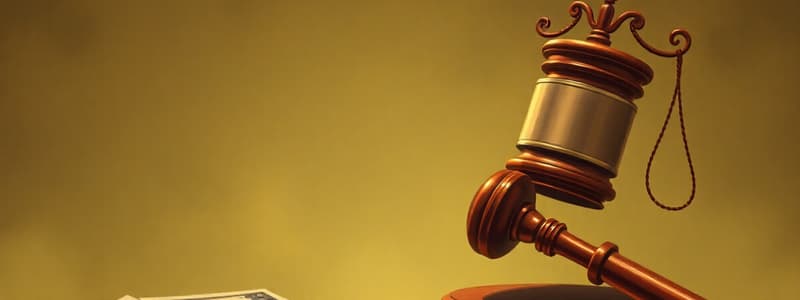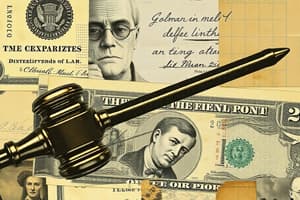Podcast
Questions and Answers
Which printing method involves creating an image by cutting lines into a printing plate?
Which printing method involves creating an image by cutting lines into a printing plate?
- Engraving (correct)
- Letterpress printing
- Casting
- Offset printing
In the context of forensic analysis, what does 'utter' most likely refer to regarding counterfeit items?
In the context of forensic analysis, what does 'utter' most likely refer to regarding counterfeit items?
- Manufacturing counterfeit coins
- Passing counterfeit coins (correct)
- Importing counterfeit goods
- Seizing counterfeit passports
Why is the edge of a coin considered the best place to examine for authenticity?
Why is the edge of a coin considered the best place to examine for authenticity?
- The edge is made of gold.
- The date is stamped on the edge.
- Special milling marks are present. (correct)
- The edge shows the coin's metallic grains.
What characteristic is typically associated with counterfeit coins?
What characteristic is typically associated with counterfeit coins?
Which of the following best describes the process of 'striking' or 'stamping' in coin manufacturing?
Which of the following best describes the process of 'striking' or 'stamping' in coin manufacturing?
What is the most important element that constitutes forgery?
What is the most important element that constitutes forgery?
Which historical event relates to the early spread of paper manufacturing knowledge?
Which historical event relates to the early spread of paper manufacturing knowledge?
What is the primary function of the Dandy Roll in paper manufacturing?
What is the primary function of the Dandy Roll in paper manufacturing?
Which of the following best describes the function of transmitted light in document examination?
Which of the following best describes the function of transmitted light in document examination?
What is a characteristic feature of 'Alkaline Writing Inks'?
What is a characteristic feature of 'Alkaline Writing Inks'?
What are the two requisites for the counterfeiting of a signature?
What are the two requisites for the counterfeiting of a signature?
What is 'anachronism' in the context of document forgery?
What is 'anachronism' in the context of document forgery?
Which type of pen was invented by Yukio Horie and introduced into the U.S. market?
Which type of pen was invented by Yukio Horie and introduced into the U.S. market?
What is the purpose of using an infrared lamp in document examination?
What is the purpose of using an infrared lamp in document examination?
What describes the 'platen' of a typewriter?
What describes the 'platen' of a typewriter?
What is the primary characteristic of a 'permanent defect' in typewriting?
What is the primary characteristic of a 'permanent defect' in typewriting?
Which term describes characters that print above or below their correct position?
Which term describes characters that print above or below their correct position?
In the historical context of paper, what material was papyrus made from?
In the historical context of paper, what material was papyrus made from?
What is the approximate number of letters per inch produced by an 'Elite' typewriter?
What is the approximate number of letters per inch produced by an 'Elite' typewriter?
Which of the following equipment gives an examiner a three dimensional enlargement?
Which of the following equipment gives an examiner a three dimensional enlargement?
Flashcards
Forgery
Forgery
The intent to deceive, punishable to maintain the integrity of the Philippines.
Engraving
Engraving
Process where lines are cut into pieces used in making paper money.
Letterpress Printing
Letterpress Printing
The most common form of printing used in making paper money.
Offset Printing
Offset Printing
Signup and view all the flashcards
Counterfeit
Counterfeit
Signup and view all the flashcards
Coins
Coins
Signup and view all the flashcards
Casting
Casting
Signup and view all the flashcards
Plaster
Plaster
Signup and view all the flashcards
Striking or Stamping
Striking or Stamping
Signup and view all the flashcards
Genuine Coins
Genuine Coins
Signup and view all the flashcards
Counterfeit Coins
Counterfeit Coins
Signup and view all the flashcards
Counterfeit Metal Money or Coin
Counterfeit Metal Money or Coin
Signup and view all the flashcards
Examination of Counterfeit Coins
Examination of Counterfeit Coins
Signup and view all the flashcards
Edge
Edge
Signup and view all the flashcards
Counterfeit Passport
Counterfeit Passport
Signup and view all the flashcards
Import
Import
Signup and view all the flashcards
Utter
Utter
Signup and view all the flashcards
Mutilation
Mutilation
Signup and view all the flashcards
Imitating (Feigning)
Imitating (Feigning)
Signup and view all the flashcards
Anachronism
Anachronism
Signup and view all the flashcards
Study Notes
Forgery
- Defined as the intent to defraud
- Punishable to maintain integrity of the Philippines
Making Paper Money
- Engraving: Lines are cut into pieces in this process
- Letterpress Printing: The most common form of printing
- Offset Printing: Achieved when a photograph is taken
Bank Note Paper
- Paper bank notes get a lot of handling
Counterfeit
- Defined as an imitation of something
Coins
- Pieces of metal stamped by the government
Making Coins
- Casting: the most common method for coin creation
- Plaster: Utilized to create molds bearing an image
- Striking or Stamping: The making of an impression
Characteristics of Coins
- Genuine coins show a flow of metallic grains
- Counterfeit coins are greasy and slimy
Counterfeit Metal Money or Coins
- Made of gold but are often seen
Examination of Counterfeit Coins
- Use a magnifying lens to examine
- Comparing a suspected coin with a known genuine coin
- Edges: Best place to examine counterfeit coins because they have special milling marks
Counterfeit Passport
- Rarely counterfeited, complicated in design
Crimes Called Forgeries
- Art. 161: Forging seal of government involves forging the signature/stamp of the president
- Art. 163: Counterfeiting coins that is false and counterfied if not authorized by government
- Art. 164: Mutilation of coins
- Art. 165: Forging treasury
- Art. 167: Counterfeiting instruments
- Art. 171: Falsification of public officer
- Art. 172: Falsification of a legislative document
- Art. 173: Falsification of wireless cable
- Art. 174: Falsification of a medical cert
Definitions
- Import: to bring into port
- Utter: to pass counterfeit coins
- Mutilation: to take off parts
- Imitating (Feigning): from the Spanish "fingiendo," means imitation, "to feign" means to present a false appearance
Obligations/Securities of the Philippines
- Bonds
- Certificates of indebtedness
- National bank notes
- Coupons
- Treasury notes
- Fractional notes
- Certificated deposits
- Bills
- Checks
- Drafts for money
- Other representatives
Falsification
- Counterfeiting or imitating a signature
- Person have participated even not
- Attributing actions to persons who did not participate
- Making untruthful statements
- Altering true dates
- Alteration or intercalation
- Issuing in an authenticated form
- Intercalating any instrument
Documents May Be Simulated
- Falsification of public documents
- Stimulation of public documents
Requisites of Counterfeiting Signatures
- Intent to imitate
- Two signatures bearing some resemblance
Week 8
- Anachronism: something out of place or time, represents difficulty for forgers
- Paper: Consists of sheets or interlaced fiber
- Watermark: Certain papers marked with translucent designs by the manufacturer, first appeared in 1270 in Italy
Tracing the Age of Paper
- Estimated through paper examination
Historical Development of Paper
- Oldest written record: Sumerian clay tablet from 4 millennium BC
- Papyrus: 3500 BC, Egypt, Palestine- Pith (soft spongy tissues of stem) sedge (grass life herb).
- Parchment: Made from the skin of animals like sheep, calves, and goats
- Vellum: Made from the fine skin of young calves or kids
Development of Paper Manufacturing
- Cai Lun: Widely known for claim invention of paper from vegetable fibers
- Paper making was kept secret for 500 years
- 7th century: The Japanese acquired paper-making techniques
- Arab City of Samarkand: Attacked by Chinese in A.D. 751
Paper Manufacturing Continues
- Middle East: papermaking travelled westward
- 16th century: Technology spread quickly
- England 1495: first paper mill
- America 1690: first paper mill
- Nicholas Louis Robert: Invented the first practical machine
- Henry Fourdrinier & Sealy: improved Robert's machine
- Ground Wood Process: First chemical pulp process discovered
- Chlorine: used for bleaching
- Esparto: a grass grown in Libya
- Straw: used to make paper in 1800
- Sulphite: paper from wood
- Oldest Manuscript: Letters dated A.D. 874
- Dandy Roll: wires on rollers, wear and tear causes damage
Discoloration
- Occurs over time due to moisture, temperature, and dust
Causes of Discoloration
- Due to the process of oxidation
- Brown spots due to molds
- Exposure to dust and dirt
- Occasional staining from fruit juice or grease
- May also occur due to heat or partial burning
Detailed Examination of Writing Material
- Collect a standard document from the issuing institution, company, or individual and compare it.
- Check with the issuing institution or company
- Conduct further physical or chemical examination
Week 9: Writing Instruments
- Manual devices are used to make alphanumeric marks on a surface
- Pen: a tool for writing with a colored fluid coming from the Latin word "Penna", which means feather
- Pen Nibs: the two divisions or points
- Ink: a fluid viscous marking
Historical Background of Writing Instruments
- Reed Pens/Swamp Reed: came from especially selected water grasses in Egypt
- Quill Pen: a hollow, horny part
- Steel Point Pens (Branzen): made from horn, tortoise shell, and gemstones
- Fountain Pens: invented in 1884 by Lewis Waterman
- Ball Point Pen: invented by John Loud
- Fiber Tip Pens: introduced into the U.S. market by Yukio Horie
- Felt-Tip Markers: made of dense or artificial fibers
Composition and Characteristics of Ink
- Indian Inks: the oldest form of Indian ink
Types of Inks
- Log Wood Inks: no longer manufactured
- Iron Gallotanate Inks: used extensively about a century ago
- Fountain Pen Inks: regarded as special fountain pen inks
- Dyestuff Inks: composed of aqueous solutions
- Water Resistant Writing and Drawing Inks: a special group of dyestuff
- Alkaline Writing Inks: quick-drying inks
- Ballpoint Pen Ink: did not appear on the European market
- Hectograph Inks: resemble stamp pad inks
- Typewriter Ribbon Inks: usually composed of a blend of aniline
- Stamp Pad Inks: made with the acid of substance
- Printing Inks: consist of a blend of aniline dyes
- Cancelling Inks: often contain carbon
- Skip Ink: manufactured by W.A. Chaffer Pen Company
Week 10: Document Handling - DOs
- Keep documents unfolded in a protective envelope
- Protective Envelope: the most useful and effective covering
- Take disputed papers to the document examiner's laboratory at the first opportunity
- If storage is necessary, keep the document in a dry place away from excessive heat and strong light
Proper Document Storage
- Once a document is disputed, it is seldom stored or filed for long
- Important documents are often kept for years
Document Handling - DON'Ts
- Do not handle disputed papers excessively
- Do not mark on the document
- Do not mutilate or damage by repeated folding, creasing, cutting, tearing, or punching
- Do not allow anyone except a qualified specialist to handle the document
Equipment of a Document Laboratory
- Room: A separate room should be built for physical examination
- Optical Equipment: Hand magnifier (a magnifying lens that is just enough in its magnification)
- Microscopes: A device used for producing a much larger view of very small objects
- Stereoscopic Microscope: gives an examiner a three-dimensional enlargement
- Forensic Comparator Microscope: three-in-one microscope, can bring together two objects into the same field
- Camera and Lens: used for discovering and proving information in court
Measuring Apparatus
- Considered as a sole basis in determining the genuineness of a document
- Hand writing measuring test plates are about a foot or fifteen inches in length
- Typewriting measuring test plates are designed to measure the typeface pitch
Special Lighting
- Visible light application
- Direct lighting: applies for photographing purposes
- Oblique lighting: positioned the lamp at one side with the source
- Side lighting: paper is held vertically
- Transmitted light: placed beneath the paper
Artificial Light Gadgets
- X-ray or Roentgen: soft radiation or Genz rays can be used to transmit light
- Ultra-violet light gadget: appears in various forms, "black light"
- Infra-red Lamp: Special type of black and white photography
Uses of Infra-Red Light
- Shows gunpowder strains
- Deciphers altered writings
- Restoration of writing
- Decipherment of obliterated writing
- Differentiates paints or pigments
- Detection and demonstration of certain secret writing
- Recording subjects in total darkness
- Addition, interlineations, or insertion detection
- Surveillance photography at night
Week 11: Typewriter
- Defines as a writing machine with a keyboard for reproducing letters on paper
Other Significant Typewriter Terms
- Alignment Defect: characters which write improperly
- Carbon Impression: striking thought carbon paper
- Character: connection with typewriting identification, the term character
- Defects: any abnormality or maladjustment
- Natural Variations: normal or usual findings
- Permanent Defect: cannot be corrected by simply cleaning
- Platen: cylinder which serve as the backing
- Proportion Spacing Typewriting: a modern form of typewriting
- Ribbon Impressions: impressions made through a cloth ribbon
- Ribbon Condition: deterioration, a measure of the ribbon's condition
- Transitory Defect: can be eliminated by cleaning the machine
- Type Face: the printing surface of the type block
Type Face Defects
- Vertical Alignment: above or below its proper position
- Horizontal Mal-alignment: character prints to the right or left
- Twisted Letter: becomes twisted and leans to the right or left of the correct slant
- Off Its Feet: heavier on one side or corner
- Rebound: character prints a double impression
- Actual Breakage: any peculiarity of typewriting's actual breakage in the line
- Clogged Typefaces: become filled with lint, dirty and inkenclosed letters such as o, e, p, and g
Identification and Examination of Typewritten Questioned Documents
- Haga: Earliest comment in writing
- Ames: exposition of the principles of typewriting
- Albert S. Osborne: the foremost document examiner (THE LANDMARKS IN TYPEWRITING IDENTIFICATION)
Types of Typewriters
- Conventional Typewriters Using Type Bars
- Pica Type: 10 letters per inch
- Elite Type: 12 letters per inch
- 6 letters per inch
- Teletype machine
- 14-16 letters per inch - special typewriters
- Typewriter Using Single Element of Ball: typewriter machines, capable of typing 10-12 characters per inch
- Typewriter Using a Pring Wheel (Electronic Typewriter): equipped with a disc-type device called a printwheel
Studying That Suits You
Use AI to generate personalized quizzes and flashcards to suit your learning preferences.



